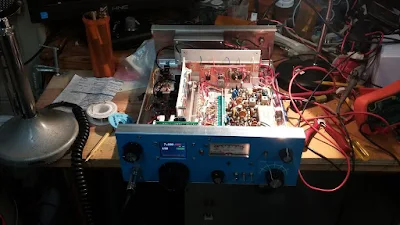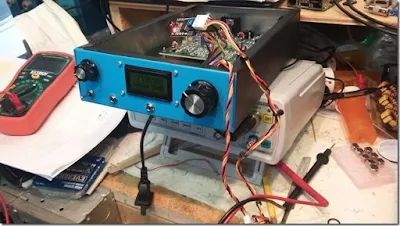Some fellow jumped into the BITX20 yahoo group this morning, casting aspersions on our friend Farhan. The fellow alleged that a lot of money was being made on the BITX 40. He seemed deeply unhappy about the shipping materials and found fault with the documentation that came with the boards.
Farhan came back with a very gentlemanly and detailed response. He was a lot more patient and temperate than I would have been. And when I think about how Pete would have responded, well, it would likely have involved -- at the very least -- a lot of colorful words from Southern Italy.
Anyway, below (unedited) is Farhan's response. I think it provides a lot of very interesting background info on our beloved BITX 40 Module and on the place that these boards come from.
thanks for writing in, I couldn't get your handle from the mail, so do excuse me for improper address! I think you have raised from valid points. I think it is important that everybody understands what tried to do, what we did and where we are now.
this is going to be a long and full of personal details that i didn't consider to be of any interest to the group and hence it was kept out. but i guess, i need to let a few cats out of the bag.
i am retired, early. i had a modestly successful run in a few businesses but i had promised myself to retire from active work, which i did around five years ago. i no longer run any for-profit businesses. most of my investment goes into 'stuff that matters'. i founded a libera cultural space in hyderabad, i am a partner in a strategic venture fund that promotes technologies that are important rather than profitable. neither ehsan nor i are any longer running anything full time. i do mentor some startups now and then but never as an investor.
i would be only too glad if someone else takes over the entire hfsigs approach. the design has been out in the open for more than a decade. apparently, it doesn't make economic sense to make them at $45 dollars a pop. so, there is nothing preventing others 'creaming the market' if they want to. surely, the turnover is modest but it is not profitable.
it is fallacy that India is cheap. In Hyderabad, a modest apartment will cost you over 250K USD. An independent house in a reasonable area goes for a million USD. A gallon of gas will costs you more than 5 dollars. smart people are hired by facebook, google and microsoft. they have a big a presence here as in the valley and seattle. there is no healthcare, all education is privatized and has to be paid. there is no social welfare. the multinationals they pay top dollar and that drives the living index up, not down. a quick indicator is that only 7% of the population of Hyderabad moves in cars and taxis and they account for 85% of the traffic congestion. our purpose is not provide the women who work low wages, but respectable wages. but i am getting ahead of myself...
Two years ago, our local club conducted India's annual hamfest. As a part of the delegates kit, Ehsan and I decided to put free BITX PCBs in the kit. These were done without any commercial interest. At this time, the hamfest was still short of money, so we decided to buy the back page ad of the souvenier to help them with the money. I had to put in something in as text, I decided to put a message in the name of HF signals (which was the name of the wiki that is still up at www.hfsignals.org). We distributed a 1000 PCBs for free. Only a few turned up on Air. It was time to do something.
Later, in 2015, I decided to conduct a workshop to help those interested in assembling the PCBs. asked them to get the components off the local shops and we settled down to do it. i discovered that a seemingly simply job of scrapping the enamel off a copper wire would take them hours and often they'd end up doing it the wrong way. the PCBs were badly designed too. we aborted the attempt. i had learnt something : homebrewing cant be taught in a day. first fail.
i also figured that it might be easier to begin with something that is already working and then start modifying it. something that happens in open source all the time. so,i sat down and designed a new single side pcb .. with through-holes, on Express Pcb. we turned up 100 boards, found a group of five young girls who were laid off after the unit where they worked to assemble TVs had closed down. showed them how to assemble the boards. they made quite a few mistakes. the transformer windings got mixed up, resistors got swapped, the transistors were inverted, etc. each board was an adventure. you can probably see some pictures of these boards floating around. they were cheap to produce. the actual component cost of the bitx is ridiculously low. it cost us about 1000 rupees in components, another two hundred for the assembly and testing and a hundred bucks to ship it. we rounded it off to Rs.1500. About 100 of them were sold. it gave me nightmares. each board took an hour or more to fix. i decided not to do it at all. we rolled up the operations after a while. second time, fail.
by now, i had given up on doing anything with bitx boards. but a conversation with convinced me that SMD might be the way to go. we looked around and found a local SMD shop that agreed to do small runs for us. the smd components are much more expensive in india. we decided to keep the more expensive components like crystals, electrolytics in through hole format. i had to learn kicad. the women were now retrained to do the windings, insertion of through hole components and two rounds of testing. the component cost was at Rs.1500, another Rs.200 to the SMD insertion machine, Rs.200 for through hole insertion, testing. add another Rs.100 for packing and Rs.100 for local posting. we were selling these for Rs.2400 inside india and 45 dollars (a few hundred more to cover the additional expense of international postage) outside.
now, we come to the packing and shipping saga. the DHL/Speed Post quoted above Rs.1500 for shipping it internationally. that would be nearly 60% of the board's sale price. instead, we looked at the ordinary postal service. so, we bought some amazon shipping cartons, assuming that these must be good enough for us as well and shipped some boards to friends around the world. we shipped five of them with the boards in bubble wrap. all fo them arrived in good shape. we rolled with this. WE USED BUBBLE WRAP. When we started actual shipping, we realized that the bubble wrap wouldn't prevent the carton from collapsing. the coils were getting damaged. we needed some kind of a stiff roof over the board so the box's sides wouldn't collapse down. That's when we started using the foam plate over the board. The foam provides a physical shield for the coils. The foam + the amazon cartons worked for a while. Then, we ran out of cartons.
Diwali is the christmas equivalent in India, the packing materials just disappeared from the market. we looked around and bought some other cardboard gift box. we sent them out as gifts to another set of people, they reported no problems, so we continued with those. after a while, we started getting complains about those boxes as well. then, we started looking around for something else.
we found these plastic boxes to be sturdy. we tossed them around, shipped them to a few volunteers around the globe and finally agreed that these were holding up. so we continued with these boxes. these boxes are costly. they are not 'cheap'. i am personally averse to using plastic, but we thought that these were the best for the purpose. if anyone has a better idea, do test it out and let us know. we are always glad to accept anything better.
2.) Secondly, components and PCBs in the Indian market are generally available at a lower cost, sometimes much lower, than components purchased from prime US suppliers such as Mouser, Newark, etc. The US is one market, India is another. That's the way it works. Components even cheaper than these: http://www.ebay.com/itm/Reel-O f-3000-MuRata-0-1uF-Multi-Laye r-Ceramic-Surface-Mount-Capaci tors-25V-X7R-/161765931843
we buy our toroids from w8diz. these are genuine micrometal parts. the pcb is of high quality made to ISO-9000 standards. we import components from mouser. the only thing that we do on the 'cheap' is that we use microprocessor grade crystals that we sort out manually.
What's the current serial numbering up to as of December. Anyone know? It was #465 in early December. 465 units multiplied by $45 USD is about $21,000 USD. That converted to INR has the purchasing power in India of $70,000 USD here in the US. That's a lot of bread.
we have shipped 1000 boards. we got 45,000 dollars in revenue and we have not yet recovered our expenses. i have provided you with the figures. add them up. as i said above there are far easier ways to follow to make money than bother with these boards. that's why no one else is doing it. the design is in open source anyway.
What's my point?
Seems like with that kind of wealth in play:
1.) The product could be double-boxed and well bubble-wrapped so it arrives undamaged after it's 12,500+ km trip from Hyderabad. Old candy boxes or scraps of waste paper taped together just isn't doing the job. Broken product means unhappy customers and a bad reputation.
as i said, bubble wrap didn't work. there will be enough people here to vouch for that. we did try it.
2.) The single schematic that represents the functionality of the product could be up-to-date and error-free.
this is the schematic that was used to produce the PCB. where are the errors?
And for totally optional bonus points: A section by section Theory of Operation write-up that explains exactly how all the sections operate and how to troubleshoot. If a template is needed, look at vintage HP test instrument manuals or Heathkit ham radio transceiver manuals. Hint: Saying that, "It's all been explained many times before on many forums, Google it." does not get any points.
surely, it could be done. probably it is already done. bitx happens to be most well documented radio now. it is a community effort. look at http://golddredgervideo.com/kc0wox/ and soldersmoke and arv's work and the large amount of stuff in the file section of the bitx group and you will realize that more people know, understand and write about bitx than a proprietory manual might contain. if you think it is lacking, go ahead and write some more documentation.
oh, btw, Ehsan is not an Ayn Rand supporter. He is a radically liberal guy who is more at home with the socialists at lamakaan than the suits of the software gang.
- f














































